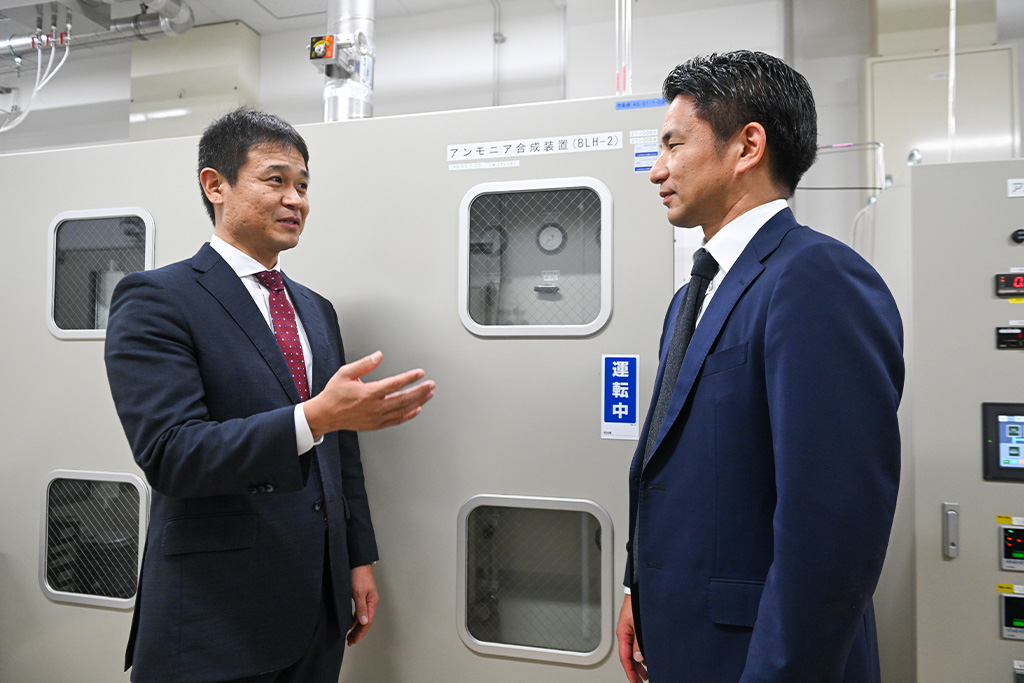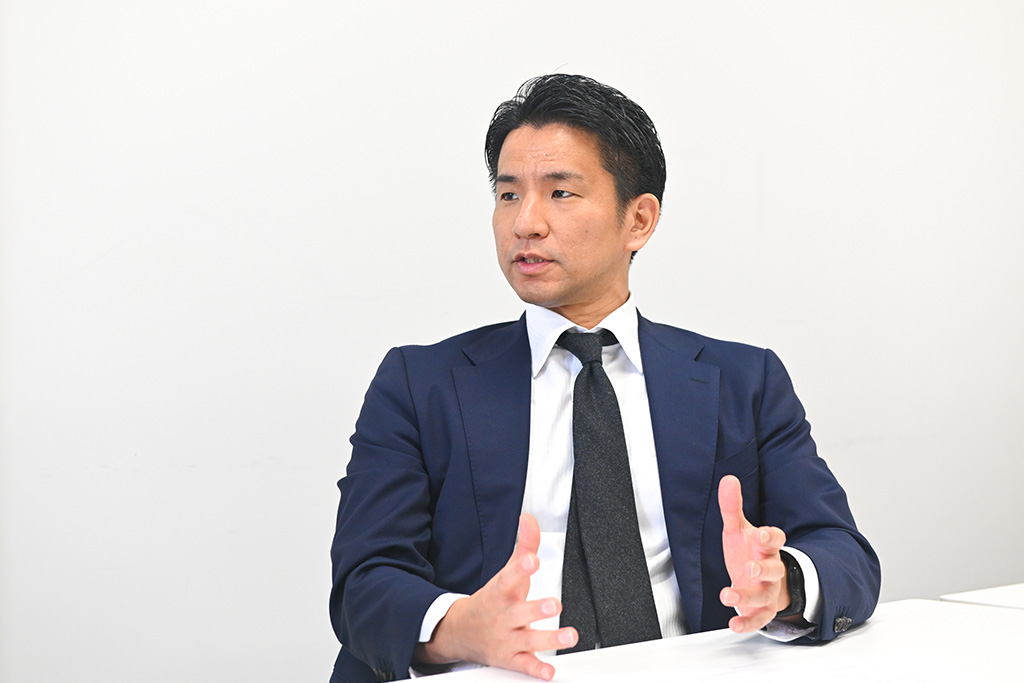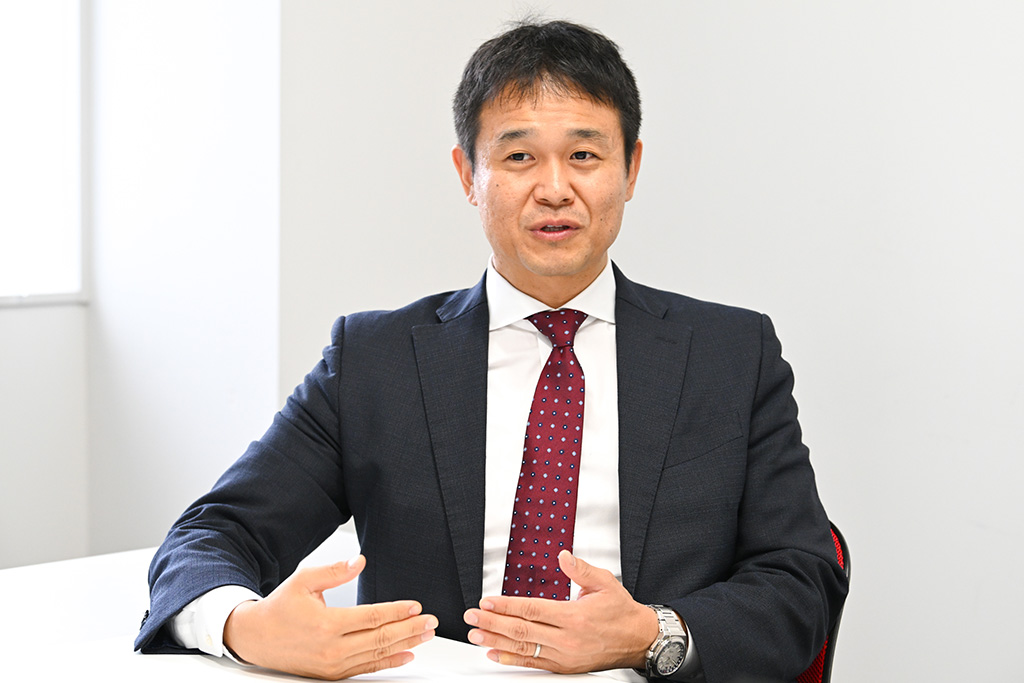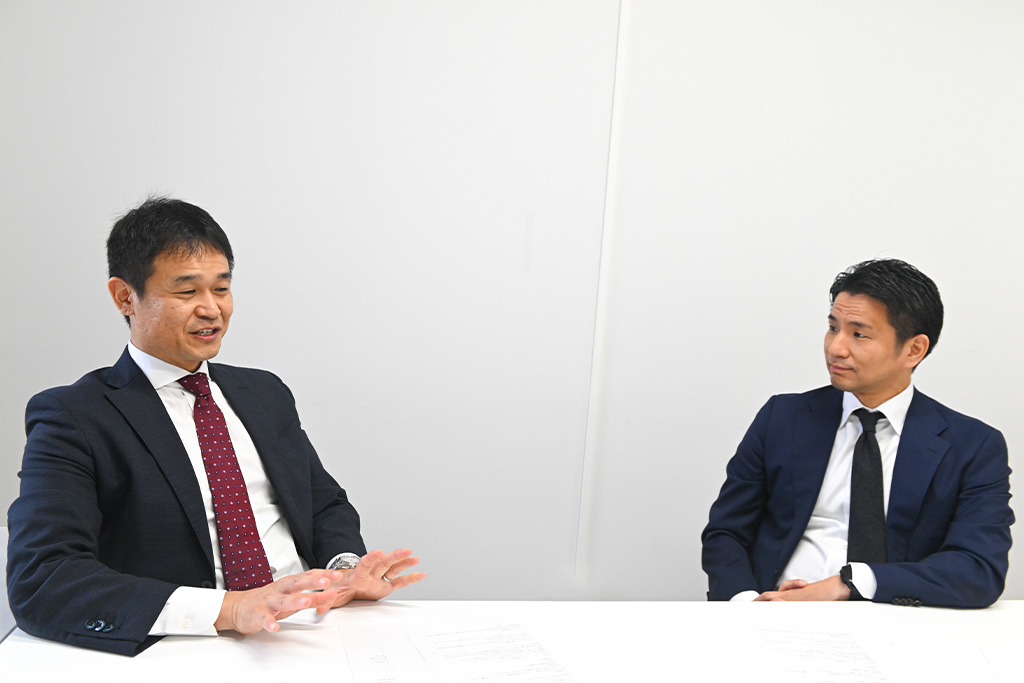![[Interview] Deep tech venture from Tokyo Tech opens a hole in the 100-year-old ammonia industry](https://ecosystem.metro.tokyo.lg.jp/wp-content/uploads/2024/02/top-imgpc0112.jpg)
![[Interview] Deep tech venture from Tokyo Tech opens a hole in the 100-year-old ammonia industry](https://ecosystem.metro.tokyo.lg.jp/wp-content/uploads/2024/02/top-imgsp0112.jpg)
![[Interview] Deep tech venture from Tokyo Tech opens a hole in the 100-year-old ammonia industry](https://ecosystem.metro.tokyo.lg.jp/wp-content/uploads/2024/02/top-imgpc0112.jpg)
Tsubame BHB Co., Ltd., a member of the Tokyo Consortium, is a venture company that is challenging the industry standard manufacturing method that has been in place for over 100 years in ammonia production. Our unique manufacturing method significantly reduces CO2 emissions compared to conventional methods, and is attracting attention in the context of decarbonization. In this conversation, Mr. Miyazawa, who is in charge of Tsubame BHB Co., Ltd. and has been supporting Tsubame BHB Co., Ltd. through his green startup support from the Tokyo Consortium, will speak with Representative Director Koji Nakamura about the business content and future business prospects. I did.
Miyazawa:Could you please introduce the origins of your company and an overview of your business?
Nakamura:Our company is a venture company originating from Tokyo Institute of Technology that aims to socially implement a small-sized ammonia production plant that can synthesize ammonia at low temperature and low pressure using the electride catalyst invented by Professor Emeritus Hideo Hosono of Tokyo Institute of Technology. It was launched in April 2017 and was established with investment from Ajinomoto, UMI (Universal Materials Incubator, Inc.), and Tokyo Tech professors.
Ajinomoto uses ammonia in its factories around the world, and we participated because we wanted to produce and use ammonia on-site. Another affiliated company, UMI, is a venture capital company that was spun out from the materials development team of a public-private fund called the Japan Innovation Network Corporation. I also belonged to UMI.
Initially, these three companies were running the project, but various companies have joined in along the way, and currently 3 companies have invested in the project. We are currently raising funds and aim to bring in new investors to expand our business and expand globally.
Why ammonia? Professor Hosono originally developed groundbreaking new materials in the electronics field. However, he realized that although this technology was ``better life,'' it was not ``essential for life,'' and he became interested in the development of food, clothing, and shelter. This led him to work on the development of an ammonia synthesis catalyst.
Our ammonia synthesis technology is carried out at low temperatures and pressures, making it possible to use compact and distributed production equipment. Taking advantage of this, we are considering introducing it at Ajinomoto factories and other locations. Recently, ammonia has been attracting attention as a key technology for decarbonization, and we are also working on the development of a new large-scale ammonia synthesis catalyst. This work is being carried out with subsidies from the Green Innovation Fund of NEDO (New Energy and Industrial Technology Development Organization). Since the project is a long-term project, the plan is to first spread the use of small-scale, decentralized manufacturing equipment, and then gradually increase the size as we accumulate results.

Miyazawa:What is behind the demand for downsizing and decentralization of ammonia production equipment? Also, could you tell us about the benefits that can be gained by realizing miniaturization and decentralization?
Nakamura:Currently, approximately 2 million tons of ammonia is produced worldwide, of which approximately 85% is used as fertilizer. Ammonia production is concentrated in a few wealthy countries, such as Japan, China, the United States, Europe, the Middle East, and gas-producing countries such as North Africa, Russia, Indonesia, and Malaysia. In fact, statistics show that areas far from these areas are lacking in fertilizer. As a result, transporting and storing ammonia and solid fertilizers becomes expensive and difficult to obtain in remote areas, making it difficult to produce crops efficiently and increasing the number of people with nutritional deficiencies.
Another factor is the high construction cost of an ammonia plant, ranging from several tens of billions of yen to 1000 billion yen. Furthermore, producing the raw material hydrogen requires fossil fuels, making it difficult to produce ammonia in areas where fossil fuels cannot be purchased. Even if the shift to "green ammonia", which produces ammonia using renewable energy, progresses, there will be no change in areas where it cannot be purchased.
To address this current situation, it is essential to develop systems that are smaller and easier to use. As renewable energy becomes more widespread and its costs come down, it will be possible to take advantage of it and use electrolysis to generate hydrogen and produce ammonia fertilizer. This will enable efficient crop production and is expected to result in a reduction in the number of malnourished people.
Miyazawa:How large will a miniaturized plant using your catalyst be compared to a regular ammonia production facility?
Nakamura:The current ammonia production method, the Haber-Bosch process, can typically produce about 70 tons of ammonia per year on average. On the other hand, the smallest of our small plants has a production capacity of about 500 tons per year. Such a small plant would allow ammonia production to be much more flexible and tailored to local demand than traditional large plants. Smaller plants also have lower investment costs and are more scaled-down in operation, making them easier to install and operate.
Miyazawa:On the other hand, compared to large-scale ammonia production, small-scale production is thought to have a certain decrease in efficiency, but are there any conditions, such as what kind of location is optimal?
Nakamura:You are right, and to put it in an extreme sense, the Haber-Bosch method improves efficiency by operating a large-scale plant, so even if we build a small-sized plant right next to it, it will be difficult to beat it in terms of profitability. there is. However, ammonia prices vary by region and directly reflect the costs of transportation and storage. For example, within Japan, there are differences in the price of ammonia depending on the region, but this is due to transportation and storage costs. Similarly, internationally, ammonia prices are influenced by transportation costs.
The most costly part of ammonia production is the electricity required to produce hydrogen, the raw material. In other words, landlocked countries where electricity costs are low and transportation and storage costs are high are ideal locations for introducing our small-scale plants. Furthermore, if renewable energy can be utilized in this process, it may lead to improved brand power. I had a meeting with the Minister of Foreign Affairs of Laos the other day, and I think there is demand for it in a country like Laos.
Miyazawa:With our support, we are continuing to consider the realization of projects that focus on the balance between supply and demand of renewable energy, and in the future we are considering hydropower generation in addition to wind power generation and solar power generation. We may be able to help your company by connecting you with businesses and projects.

Nakamura:It is true that the cost of renewable energy is an important factor in ammonia production. Looking around the world, we can see cases where renewable energy investment is progressing in countries and regions, such as IRA in the United States and solar projects in India. Even for small Japanese venture companies, it is important to keep an eye on overseas markets and understand trends in renewable energy. We have a global perspective, not just within Japan, and aim to target markets with pinpoint precision. We have gathered members who can do this, and we are currently in the process of setting it up.
Miyazawa:You attended Prime Minister Kishida's visit to the Middle East, and I believe you signed MOUs (memorandums of understanding) with local companies and government agencies before and after that visit.What role does the Middle East have for your company?
Nakamura:It is certain that the Middle East, which is rich in energy resources, is a promising region for the production of ammonia in the future. Relations with the Middle East are also important for Japan's energy strategy. Additionally, as decarbonization progresses around the world, the UAE, an oil-producing country in the Middle East, is actively investing in new technologies that will become the pillars of its future economy. In this context, the UAE has established the Japan-UAE Advanced Technology Coordination Scheme (JU-CAT) with the Japanese government. For our first project, we have concluded a "Joint Study Agreement" with ADNOC (Abu Dhabi National Oil Company) and plan to jointly conduct a business study on green ammonia production. We have also signed an MOU with Masdar, a local state-owned renewable energy company. By combining the UAE's renewable energy with our ammonia production technology, we have the potential to produce green ammonia at a competitive price in the future.
Miyazawa:I believe that your company's distinctive feature lies in its catalyst technology, but could you tell us about its strengths as a venture company originating from Tokyo Tech?
Nakamura:Having a lab at Tokyo Tech is very important. We have members from corporate, marketing, and plant design. The difference from large companies is that most of the elements are covered by Tokyo Tech.
It is important to enter business from a needs perspective. It is necessary to listen to the voices of customers and partner companies, and if this is difficult, consider whether it is possible. These voices are sent as information from the marketing department to the process and catalyst teams, where discussions are held with Professor Emeritus Hosono and Professor Masaaki Kitano, also of Tokyo Tech. At the meeting, discussions such as ``This technology may be interesting in the paper, but is it suitable for commercialization?'' and ``If this doesn't work, can we do this?'' were held, and based on these discussions, our mass production team decided to commercialize it. We are currently considering the following. We are proud of the fact that we have an environment where academic and business specialists gather in one place and communicate closely, similar to the PDCA cycle, which is a strength that cannot be imitated by large companies.
Academia is required to write papers and obtain patents, but our role is to identify usable technologies, effectively introduce them to the market, and reduce costs. This is not something academia usually does. On the other hand, while looking at technologies and papers from around the world, coming up with an idea like ``Maybe we can generate ammonia with this'' is not an area in which we are good at, and requires the expertise of academia. I believe it is extremely important to effectively incorporate ideas like this and divide roles.
Miyazawa:This means that it is extremely important for academia or research organizations to work together smoothly with front-line departments such as sales and marketing that are in daily contact with customers. However, on the other hand, I think it can be difficult to bring together an organization with different philosophies, cultures, speeds, and ways of thinking that intersect. Under these circumstances, what did you think about the work we worked together on in the summer to formulate the behavioral guidelines and vision, mission, and values?
Nakamura:It was extremely valuable. Our company had a mission and vision that we had originally created, but these were not fully understood and some parts of the company had become mere shells. Regarding values, the challenge was that people had different backgrounds such as trading companies, automobile companies, consulting, engineering, and the chemical industry, and there were also generational differences, so they had different values.
In order to bring them together and move forward with the business with a sense of speed, we needed to enlist the help of professionals. During this process, with the help of Mr. Miyazawa and the Tokyo Consortium, we held three company-wide workshops on formulating the mission, vision, and values, and re-created them based on the results. The fact that this initiative began at the end of June, when I took over as CEO, had a positive impact on my start in the new organization. This deepened our common understanding and clarified the direction we should take.

Miyazawa:I understand that your company is a representative company among university-launched deep tech and climate change-related startups, but generally speaking, the reality is that it is difficult for startups in such fields to grow in Japan. think. Could you please tell us what particular challenges your company is facing?
Nakamura:Deep tech projects usually require funding and human resources. It takes a long time to see results, and although orders have been received, there are many cases where operations will not begin until two years later. In other words, large companies place emphasis on track record when placing orders, but venture companies have difficulty proactively making proposals when they do not yet have a track record. Some of our customers are pioneers who actively participate in the initial innovations, while others are laggards who are anxious or cautious about new technologies. In that sense, I feel that the first "zero one" stage is quite difficult.
Quality assurance is also an important aspect of deep tech projects. We have been operating the pilot plant for four years since December 2019, but we have occasionally received concerns about future durability, such as "Will it continue to work for 12 or 4 years?" This is a common challenge in other deep tech fields, but when introducing a new material or technology, it is necessary to predict its lifespan in advance.
To predict lifespan, it is necessary to construct an estimation formula based on previous research and papers. However, in the deep tech field, there are few experts who understand such predictive models. Especially in the case of OEM production like ours, we are required to clearly define delivery specifications, lower criteria, upper criteria, etc. I believe that deep tech is particularly difficult because it requires unique approaches and skills not only in research but also in business and markets.
Another point to consider in the area of climate change is the "green premium." This refers to the idea that environmentally friendly products and services should be traded at higher prices than normal. However, reality has not yet caught up. In reality, there will be competition with fossil fuels, and it is difficult to balance this with economic efficiency. To deal with this, it is necessary to develop an evaluation and system for environmental considerations at an international level.

Miyazawa:Could you tell us about your company's expectations when you applied to the Tokyo Consortium?
Nakamura:Although we are a venture company in Japan, overseas expansion is essential. This is because, although the world produces 2 million tons of ammonia, domestic demand is currently less than 100 million tons, or only in the 70-ton range. In other words, considering that 99% of ammonia demand is in overseas markets, we must actively expand into overseas markets.
On the other hand, we currently have 15 shareholders, all of which are Japanese companies. There is an urgent need to expand overseas, but the system for doing so is not yet in place. One thing we are looking forward to is the introduction of overseas investors. We would like to hear from you about potential overseas partners and potential customers. Ultimately, I hope that a company will emerge that our stations can collaborate with, so I would appreciate your help.
Miyazawa:I've got it. Just last week, we were able to connect with an overseas company, and we hope to continue to utilize our global network to provide support. By the way, which country in particular do you have the highest need for partner introductions?
Nakamura:It's Africa. Fertilizer is the most expensive country in the world, so we would like to focus on Africa.
Miyazawa:got it. Lastly, could you give a message to companies that are thinking of applying to the Tokyo Consortium?
Nakamura:Although there are aspects of the green field that are difficult to commercialize, I think it is extremely important to receive advice from people with a lot of experience rather than proceeding with the project on your own. I had used a consultant before, but the results were unsatisfactory considering the amount of money spent. I feel that the support from Tokyo Consortium has exceeded my expectations. We will continue to actively share information and communicate any concerns we may have, so we look forward to continuing to value communication and building relationships of mutual trust. I feel that Mr. Miyazawa and other members of the Tokyo Consortium not only have great business ability but also great humanity. They are very easy to talk to and reliable, so if you are unsure about applying, please give it a try.
Koji Nakamura
Tsubame BHB Co., Ltd. Representative Director and CEO
After joining Toyota Tsusho Corporation, he was seconded to the Materials Technology Department of Toyota Motor Corporation and Toyota Motor Asia Pacific Engineering and Manufacturing Co., Ltd., Toyota's ASEAN headquarters, as an organic materials engineer, and worked in the ASEAN and India regions. Responsible for supplier process audits and evaluation of local materials. At Toyota Tsusho Corporation, he was engaged in establishing new businesses, developing new customers, and overseas transactions.
In 2017, he joined Universal Materials Incubator Co., Ltd., a venture capital firm that invested in Tsubame BHB Co., Ltd. Participated in Tsubame BHB Co., Ltd. from April 2019. He was appointed as a director of the company in January 4 and representative director and CEO in June 2022.